Stability analysis for grain yield and yield attributing traits in Basmati rice varieties
Bạn đang xem bản rút gọn của tài liệu. Xem và tải ngay bản đầy đủ của tài liệu tại đây (375.07 KB, 12 trang )
Int.J.Curr.Microbiol.App.Sci (2018) 7(11): 1792-1803
International Journal of Current Microbiology and Applied Sciences
ISSN: 2319-7706 Volume 7 Number 11 (2018)
Journal homepage:
Original Research Article
/>
Stability Analysis for Grain Yield and Yield Attributing Traits
in Basmati Rice Varieties
C. Visalakshi Chandra* and Indra Deo
Department of Genetics and Plant breeding, G. B. Pant University of Agriculture and
Technology, Pantnagar, Uttarakhand, India
*Corresponding author
ABSTRACT
Keywords
Rice, Stability, Yield
attributing traits, Stability
parameters
Article Info
Accepted:
15 October 2018
Available Online:
10 November 2018
A field experiment was conducted to evaluate 30 basmati rice genotypes for their stability
for yield and yield attributing traits over three growing seasons. Fifteen randomly selected
plants were sampled in the middle row of each plot and were used for the analysis. The
study indicated that environment + (genotype x environment) was significant for all the
characters studied thereby validating the distinctness of the environments considered. The
GXE (linear) was highly significant for all the traits considered. This implies that the
genotypes varied in linear response to the environments and hence the behaviour of the
genotypes could be predicted over environments more accurately. Based on stability
parameters and mean, UPR 2825-30-1-2, UPR 3717-4-1-1, Hansraj, IR 36 and IR 64 were
found to be stable for yield in all the three environments considered.
Introduction
Rice, Oryza sativa L. (2n=24) is the most
important cereal crop of India. Worldwide,
more than 3.5 billion people depend upon rice
for more than 20% of their daily calories
(Khush, 2013). In most of the developing
world, rice availability is equated with food
security and closely connected to political
stability. Also the genetic and functional
syntenies among cereal crops over the years
has made rice the most important cereal crop
for the discovery and utilization of
agronomically important genes for crop
improvement. India, being one of the original
centres of rice cultivation is the second largest
producer and consumer of rice in the world
(USDA- ERS, 2013). Rice is the most
important agricultural operation in the
country, not only in terms of food security but
also in terms of livelihood. It plays a major
part in the diet, economy, employment, culture
and history of India.
As this crop is grown under a varied range of
agro-climatic conditions ranging from upland
to lowland and irrigated to rainfed situations,
their phenotypic responses vary greatly in
accordance with the environment. The major
efforts in crop technology, under unfavourable
environment should be yield stabilizing, cost
reducing, risk minimizing and returns
enhancing. The genotypes should therefore be
high stability cultivars besides high yielding
1792
Int.J.Curr.Microbiol.App.Sci (2018) 7(11): 1792-1803
cultivars. As a result, several methods of
measuring and describing genotypic response
across environments have been developed a
utilized. For this purpose, multilocational
trials, over a number of years are conducted.
Sometimes unilocational trials can also serve
the purpose provided different environments
are created by planting experimental materials
at different dates of sowing, using various
spacing, doses of fertilizers and irrigational
levels, etc. Many methods (Finlay and
Wilkinson, 1963; Eberhart and Russell, 1966;
Perkins and Jinks, 1968; Freeman and Perkins,
1971) are available for assessing the stability
of performance of crop varieties. These
models are helpful in the identification of
adaptable genotypes over a wide range of
environments; achieving stabilization in crop
production over locations; developing
phenotypically stable high potential cultivars;
effective selection for yield stability and
prediction of varietal responses under
changing environments. Yield is a complex
quantitative character and is greatly influenced
by environmental fluctuations; hence, the
selection for superior genotypes based on
yield per se at a single location in a year may
not be very effective. Thus, evaluation of
genotypes for stability of performance under
varying environmental conditions for yield has
become an essential part of any breeding
programme. Keeping the above views in mind,
the present investigation was conducted to
analyse the stability of the rice genotypes
across three growing seasons.
the Shivalik ranges of the Himalayas in a
narrow belt called „Tarai‟. It falls under the
humid
subtropical
climate
zone.
0
Geographically, it is situated at 29 51‟ N
latitude, 790 31‟ E longitudes and at an
altitude of 243.84 meters above the mean sea
level.
Materials and Methods
Variability for yield and yield component
traits over the three growing seasons
Experimental materials
The plant material comprised of 4 landraces, 7
advanced breeding lines from rice breeding
programme of Pantnagar, 2 germplasm
accessions from Pantnagar Centre of Plant
Genetic Resources (PCPGR, Pantnagar,
Uttarakhand) collected from hills of
Uttarakhand, 6 released varieties from various
research stations and State Agricultural
Universities (SAUs), 11 kalanamak local
accessions collected under DBT-PMS Project.
Two additional genotypes namely IR 64 and
Pusa Basmati 1 were included as resistant and
susceptible checks for blast resistance
respectively making a total of 30 rice
genotypes (Table 1). The mean values for
different quantitative traits such as Days to
50% flowering, Plant height, Number of
panicles per plant, Length of panicle, 1000
grain weight and Grain yield per five plants
were used for stability analysis. The stability
parameters were calculated as per the
procedure given by Eberhart and Russell
(1966).
Results and Discussion
Experimental site
The present study was carried out in the fields
of Norman E Borlaug Crop Research Centre
(NEBCRC), Govind Ballabh Pant University
of Agriculture and Technology, Pantnagar
over three growing seasons 2012, 2013 and
2014. Pantnagar is located at the foothills of
Analysis of variance indicated significant
variation for all the characters studied in all
the three growing seasons, suggesting the
availability of wider genetic variation.
Presence of similar variation was reported in
earlier studies (Tariku et al., 2013, Akter et
al., 2014, Lakew et al., 2014), indicating that
1793
Int.J.Curr.Microbiol.App.Sci (2018) 7(11): 1792-1803
the genetic behavior of the genes influencing
the characters such as days to 50% flowering,
plant height, number of panicles per plant,
panicle length and 1000 grain weight and
yield per five plants gives enough opportunity
for the improvement of these traits by
following conventional plant breeding
methods. The days to 50% flowering during
2012 varied from 90.66 -133.6, while it ranged
from 91.66- 135.66 and 92-134.33 during
2013 and 2014 respectively. In case of plant
height, during 2012 the values ranged from
73-144.36, 70.8 -145.1 and 76.86-142.16
during 2013 and 2014 respectively. The value
for number of panicles were 5-8.66 during
2012, 5-8.33 during 2013 but in 2014, the
values were comparatively less which was 48.66. During 2012, the variation for panicle
length was 21.93-32.03 while it was 14.1229.92 during 2013 and 23.36- 33.38 during
2014 The 1000 grain weight showed wide
variation with the following range during
2012, 2013 and 2014; 7.84 -26.09, 11.2427.04 and 10.96-25.49 respectively.
The yield per five plants also varied widely
between 10.11-47.04 in 2012, 6.39-40.22 in
2013 and 5.55-47.09 during 2014. Genotypes
contributing to high diversity for grain yield
was found at environment 1 (Kharif 2012),
while narrow diversity at environment 2
(Kharif, 2013) and environment 3 (Kharif
2014). Mean grain yield of the genotypes
varied in every environment ranging from
22.93g for environment 1 to 20.66 g for
environment 2 with a grand mean of 21.56g.
Variations of this kind may be caused by
several factors such as rainfall, soil fertility
etc. Unpredictable environmental factors such
as temperature and rainfall even in a single
year may contribute to genotype by
environmental interaction over year. In the
present study, the years during which the field
experiments were conducted, the weather
conditions varied significantly; thus, a large
effect due to environment was expected.
Therefore testing genotypes over different
years differing in unpredictable environmental
variation is a suitable approach for selecting
stable genotypes (Eberhart and Russel, 1966).
Stability analysis
The analysis of variance of stability (Table 2)
following Eberhart and Russell‟s model
showed that the variance due to genotypes was
found to be significant only for yield per five
plants and was non-significant for all the other
characters studied. This indicates that the
performance of the genotypes did not vary
significantly over the three growing seasons
(Kharif, 2012, Kharif, 2013 and Kharif, 2014)
with respect to these traits except yield per
five plants. Similar results were reported by
Ramanjaneyalu et al., (2014). The variance
due to environments interaction was highly
significant for all the characters. The
significant and relatively large percentage of
the total variation attributable to environment
suggests that the environments (three growing
seasons) considered were significantly
different. Highly significant mean squares due
to genotype × environment (G×E) interaction
for yield per plant revealed that the genotypes
interacted considerably with environmental
conditions and that yield per plant differed
significantly in each of the growing seasons
considered. The characters such as Days to
50% flowering, plant height, number of
panicles per plant, panicle length and 1000
grain weight showed non-significant GXE
value indicating that the performance of the
genotypes was stable over the three growing
seasons for these traits. The variation due to
environment (linear) was highly significant for
all the characters under study indicating
differences between environments and their
influence on genotypes for expression of these
characters. The significant environment
(linear) variance implies that the variation
among environments were linear, which
signify unit changes in environmental index
1794
Int.J.Curr.Microbiol.App.Sci (2018) 7(11): 1792-1803
for each unit change in the environmental
conditions. This is in accordance with
previous reports on rice by Masavi et al.,
(2012). The GXE (linear) was highly
significant for all the traits considered. This
indicated significant differences among the
genotypes for linear response to environments
(bi) behaviour of the genotypes could be
predicted over environments more precisely
and G X E interaction was outcome of the
linear function of environmental components.
Both linear and non-linear components of
genotype-environment interaction were found
to be significant for grain yield as indicated by
highly significant mean squares due to GXE
and G×E (linear) interaction of 128.330 and
213.70 respectively. The existence of
genotype x environment interactions and
contribution of both linear and non-linear
components for yield was reported by Bose et
al., 2012. The pooled deviations were found
highly significant for 1000 grain weight and
yield per plant.
The highly significant pooled deviation for
both the traits suggests the importance of non
– linear component in the manifestation of
GXE interaction, or in other words, expression
of some of the genotypes fluctuated
significantly from their respective linear path
of response to environments. The performance
of the genotypes was entirely unpredictable in
nature for these two traits. The pooled
deviation was insignificant for other traits
such as Days to 50% flowering, plant height,
number of panicles per plant and panicle
length indicating that these traits had linear
sensitivity. These results were consistent with
the findings of Ramanjaneyalu et al., 2014.
The environmental index is defined as the
deviation of the mean of all the genotypes at
the regression of the ith environment from the
overall mean. In other words it indicates the
favorability of an environment or growing
season over the others considered. The
environmental index was positive for Kharif,
2012 indicating better overall environment or
favorable environment than the other two
growing seasons which had environmental
index values -0.45 and -0.77 respectively.
Stability parameters
The GXE interaction was highly significant
only for yield per five plants. Therefore
stability parameters were studied further.
Relatively higher value of the linear
component as compared to non-linear one
suggested the possibility of prediction of
performance for yield over the environments.
Therefore, linear (bi) and nonlinear (S2di)
component of G x E interactions were
considered while judging the phenotypic
stability of a genotype (Finlay and Wilkinson,
1963; Eberhart and Russell, 1966). In this
study, the mean performance coupled with the
stability parameters of each rice genotype
represented its stability are showed in Table 3.
Stability parameters like regression coefficient
(bi), and deviation from regression (S2di) of
the genotypes were estimated following
simple linear regression method “LR model”
(Finlay and Wilkinson, 1963; Eberhart and
Russell, 1966).
Eberhart and Russell (1966) defined a stable
genotype as the one which showed high mean
yield, regression co-efficient (bi) around unity
and deviation from regression near to zero.
Accordingly, the mean and deviation from
regression of each genotype were considered
for stability and linear regression was used for
testing the varietal response.
Genotypes with high mean, bi = 1 with nonsignificant δ2 di are suitable for general
adaptation,
i.e.,
suitable
over
all
environmental conditions and they are
considered as stable genotypes.
1795
Int.J.Curr.Microbiol.App.Sci (2018) 7(11): 1792-1803
Table.1 List of rice genotypes studied
S. No
1.
Genotypes
Hansraj
S. No
16.
Genotypes
Kalanamak 3216-SN
2.
Tilakchandan
17.
Kalanamak 3128-SN
3.
Daniya
18.
Kalanamak 3114-1-SN
4.
Sarbati
19.
Kalanamak 3131-P
5.
UPR 3488-6-2-1
20.
Kalanamak 3259-SN
6.
UPR 3716-1-1
21.
Kalanamak 3131-SN
7.
UPR 3713-16-1-2
22.
Kalanamak 3124-P
8.
UPR 3717-4-1-1
23.
Kalanamak 3121-1
9.
UPR 2825-30-1-2
24.
Kalanamak 3119-P
10.
UPR 2892-4-1-1
25.
Kalanamak 3089-P
11.
UPR 3618-15-1-2
26.
Pusa Basmati 1 (Susceptible control)
12.
Pant Basmati 1
27.
IR 64 (Resistant control)
13.
GP 2011-56(A)
28.
IR 36
14.
GP 2011-24
29.
Taraori Basmati
15.
Kalanamak 3216-N
30.
Pant Sugandh Dhan 17
Table.4 Top three performing genotypes for yield and yield components during
Three growing seasons
Trait
Yield per five
plants
1000 grain weight
Panicle length
No. of panicles
Kharif 2012
UPR 3717-4-1-1
UPR 3618-15-1-2
UPR 3488-6-2-1
IR 36
UPR 2892-4-1-1
UPR 3716-1-1
Kalanamak 3216-N
Kalanamak 3131-P
UPR 2825-30-1-2
UPR 2825-30-1-2
Hansraj
IR 64
Kharif 2013
UPR 2825-30-1-2
Kalanamak 3216-SN
UPR 3618-15-1-2
IR 36
IR 64
Taraori basmati
Pant Sugandh Dhan 17
Taraori basmati
IR 36
Hansraj, UPR 2825-301-2
Sarbati, Pant Basmati 1
Tilakchandan,
Kalanamak 3216-N
1796
Kharif 2014
UPR 3618-15-1-2
Hansraj
Kalanamak 3216-N
IR 64
IR 36
UPR 3618-15-1-2
Kalanamak 3216-N
Kalanamak 3131-P
Pant Sugandh Dhan 17
Hansraj
UPR 2892-4-1-1, IR
64
UPR 3488-6-2-1, Pant
Basmati 1
Int.J.Curr.Microbiol.App.Sci (2018) 7(11): 1792-1803
Table.2 Analysis of variance for yield and yield attributing traits (Eberhart and Russell Model, 1966)
Source of
variation
d.f.
Days to 50%
flowering
Plant height
No. of panicles
per plant
Panicle length
1000 grain
weight
Yield per plant
Genotype (G)
29
113.227
120.51
119.653
100.59
157.177
200.32*
Environment (E)
2
83,221**
88,863.57**
96,083.159**
92002.36**
92998.86**
87,989.96**
Genotype X
Environment
58
132.663
163.463
109.617
115.60
113.80
128.330**
Environment +
(Genotype X
Environment)
Environment
(Linear)
60
2902.28**
3120.13**
3308.73**
3178.49**
3209.970**
3056.95**
1
166‟442.87**
177,727.150**
192,166.31**
184,004.726**
185,997.73**
175973.92**
Genotype X
Environment
(Linear)
Pooled deviation
29
208.711**
264.82**
165.55**
176.303**
164.92**
213.70**
30
54.728
60.03
51.890
53.076
60.589**
41.52**
Pooled error
174
195.986
195.068
114.551
115.117
98.617
67.801
Total
89
* Significant at 5 % level ** Significant at 1 % level
1797
Int.J.Curr.Microbiol.App.Sci (2018) 7(11): 1792-1803
Table.3a Stability parameters for days to 50% flowering, plant height and No. of panicles per plant in different genotypes over
environments
Genotypes
Days to 50% flowering
Plant height
No. of panicles per plant
_
Xi
bi
S2dii
_
Xi
bi
S2dii
Xi
bi
S2dii
Hansraj
44.12
0.48
201.91
56.02
0.84
182.25
45.70
0.97
35.89
Tilakchandan
43.31
0.94
24.54
44.67
0.95
26.90
44.64
0.93
21.77
Daniya
45.11
1.03
21.75
49.85
1.14
-8.53
50.56
1.13
9.37
Sarbati
50.27
1.34
-55.52
50.80
1.30
-48.62
50.24
1.26
-35.84
UPR 3488-6-2-1
44.25
1.04
-12.64
45.23
1.03
-17.86
45.49
0.97
10.86
UPR 3716-1-1
42.23
1.00
-45.38
44.19
1.02
-36.06
45.21
0.99
-0.95
UPR 3713-16-1-2
43.41
0.96
2.48
44.81
0.96
18.93
43.36
0.90
12.84
UPR 3717-4-1-1
47.09
1.07
2.84
50.11
1.16
28.59
49.01
1.10
4.72
UPR 2825-30-1-2
51.01
1.33
-60.87
50.77
1.32
-45.50
51.61
1.26
-27.06
UPR 2892-4-1-1
44.42
1.07
-33.13
43.93
1.01
-19.70
44.81
0.98
0.50
UPR 3618-15-1-2
42.58
1.00
-38.02
44.15
1.03
-37.18
44.72
0.98
7.19
Pant Basmati 1
43.20
0.93
20.50
44.89
0.96
26.66
42.26
0.88
10.61
GP 2011-56(A)
45.88
1.06
24.93
50.96
1.17
-9.50
49.72
1.12
14.69
GP 2011-24
50.61
1.36
-49.05
50.80
1.30
-48.62
51.14
1.25
-28.62
Kalanamak 3216-N
45.36
1.07
-13.77
44.79
1.01
-17.51
44.50
0.97
7.59
Kalanamak 3216-SN
42.88
0.76
-64.67
34.35
0.41
-63.18
51.96
0.93
-38.16
Kalanamak 3128-SN
58.71
0.99
-61.70
49.53
0.69
-65.02
49.57
0.73
-5.98
1798
Int.J.Curr.Microbiol.App.Sci (2018) 7(11): 1792-1803
Genotypes
Days to 50% flowering
bi
S2dii
Kalanamak 3114-1-SN
Kalanamak 3131-P
Kalanamak 3259-SN
Kalanamak 3131-SN
Kalanamak 3124-P
_
Xi
56.79
56.94
50.71
52.50
57.26
0.91
1.06
1.01
0.97
0.96
Kalanamak 3121-1
57.01
Kalanamak 3119-P
Contd……
No. of panicles per plant
Plant height
bi
S2dii
-65.20
-7.81
65.01
-29.59
-63.82
_
Xi
55.52
63.33
51.69
51.82
54.69
bi
S2dii
0.90
1.27
0.95
0.80
0.94
-63.78
7.65
42.43
-44.42
-35.60
61.40
62.38
50.29
51.93
49.97
1.02
1.19
0.91
0.86
0.75
-37.09
53.27
130.76
-0.40
-7.87
0.97
-65.32
55.85
0.89
-64.11
62.52
1.07
-35.46
56.36
1.09
14.00
63.07
1.25
38.21
64.05
1.28
29.46
Kalanamak 3089-P
49.93
1.00
54.32
51.36
1.02
96.01
50.24
0.90
133.823
Pusa Basmati 1
48.16
0.78
-26.46
49.29
0.71
-41.18
46.83
0.66
-13.49
IR 64
43.40
0.63
-54.38
48.17
0.71
-28.89
49.88
0.76
-10.83
IR 36
55.84
0.90
-63.38
55.84
0.90
-63.98
63.24
1.09
-38.05
Taroari Basmati
64.42
1.36
11.60
62.76
1.28
12.30
57.69
1.05
54.83
Pant Sugandh Dhan 17
44.52
0.82
48.85
50.57
0.96
129.70
51.92
0.97
152.73
MEAN
49.31
1.00
50.47
1.00
50.89
1.00
SE
5.23
0.09
5.48
0.10
5.09
0.09
1799
Xi
Int.J.Curr.Microbiol.App.Sci (2018) 7(11): 1792-1803
Table.3b Stability parameters for Panicle length, 1000 grain weight and Yield per five plants in different genotypes over
environments
Xi
46.24
44.77
Panicle length
bi
.98
0.94
Xi
42.32
43.99
1000 grain weight
bi
0.99
0.92
Xi
44.31
43.65
Yield per five plants
bi
0.99
0.93
S dii
7.76
16.12
S dii
-29.38
37.85
S2dii
-3.43
46.40
49.62
1.14
24.34
48.72
1.08
62.84
46.77
1.12
5.40
50.31
1.25
-38.15
51.03
1.28
-27.29
51.24
1.30
-9.1
45.51
0.97
13.15
41.82
0.87
46.34
40.98
0.88
37.13
44.83
1.00
-18.63
44.52
0.96
-3.45
43.93
1.00
-2.26
42.26
0.90
-2.64
42.57
0.89
21.49
43.86
0.92
42.54
49.50
1.15
3.23
47.06
1.08
45.58
47.21
1.16
9.48
51.36
1.27
-36.89
49.92
1.26
-9.99
51.08
1.31
-12.79
44.83
0.99
-13.65
39.99
0.83
26.74
40.41
0.88
29.79
45.67
1.00
-19.40
44.34
0.97
2.31
43.84
1.01
-4.24
44.77
0.94
16.21
43.54
0.91
38.46
43.87
0.93
50.51
49.07
1.13
28.90
48.28
1.07
63.54
47.80
0.16
28.31
50.09
1.29
-33.49
50.69
1.27
-27.16
50.35
1.28
-15.77
46.18
1.00
15.08
41.38
0.85
47.07
41.17
0.89
28.78
47.21
0.73
-29.53
53.22
0.78
-28.48
44.11
0.63
-12.80
56.18
60.16
0.72
1.08
-23.96
-22.96
53.35
62.10
0.75
1.08
-4.30
-14.43
46.87
59.62
0.70
1.03
-9.51
-12.62
57.36
1.05
42.22
62.33
1.21
49.62
63.26
1.27
66.28
2
1800
2
Int.J.Curr.Microbiol.App.Sci (2018) 7(11): 1792-1803
Panicle length
Contd……
Yield per five plants
1000 grain weight
Xi
bi
S2dii
Xi
bi
S2dii
Xi
bi
S2dii
52.41
0.98
198.10
51.30
0.98
56.72
42.59
0.73
69.38
49.32
0.64
-37.12
47.21
0.76
15.26
52.39
0.81
-22.27
55.05
0.70
-23.60
47.88
0.83
13.89
51.55
0.83
-0.62
62.93
1.12
-36.30
63.75
1.10
-15.70
59.31
1.03
-14.15
57.32
1.08
90.30
63.51
1.24
101.24
66.29
1.37
64.46
52.01
0.98
170.93
50.15
0.99
125.19
43.71
0.79
59.59
56.83
0.88
-33.83
51.74
0.81
-28.57
53.90
0.90
5.26
49.46
0.75
-8.88
49.02
0.82
49.75
52.77
0.97
-0.39
60.08
1.06
-28.64
62.63
1.07
-18.03
59.72
1.02
-11.22
64.24
1.22
83.46
62.03
1.21
82.97
58.78
1.14
64.64
50.65
0.92
144.39
50.68
0.98
151.29
45.38
0.85
91.12
51.17
1.00
50.38
1.00
49.37
1.00
5.15
0.09
5.50
0.09
4.56
0.08
1801
Int.J.Curr.Microbiol.App.Sci (2018) 7(11): 1792-1803
Genotypes with high mean, bi > 1 with nonsignificant δ2 di are considered as below
average in stability. Such genotypes tend to
respond favourably to better environments but
give poor yield in unfavourable environments.
Hence, they are suitable for favourable
environments. Genotypes with low mean, bi <
1 with non-significant δ2 di do not respond
favourably to improved environmental
conditions and hence, it could be regarded as
specifically adapted to poor environments.
and 43.84 respectively. The highest mean was
observed for Kalanamak 3119-P but it
showed (bi) value greater than one and highly
significant deviation (S 2dii) and therefore it
can be concluded that it may not be a stable
variety. The genotype Kalanamak 3131-P had
high mean value (63.26), bi close to one and
low S2dii value indicating that this genotype
is more stable with high mean over all the
growing seasons considered (Table 3a & b).
Categorization of genotypes
Genotypes with any bi value with significant
δ2 di are unstable
Among the 30 genotypes, the regression
coefficient for yield per five plants was near
to unity in six genotypes namely, Hansraj,
UPR
3716-1-1,
UPR
3618-15-1-2,
Kalanamak 3114-1-SN, Kalanamak3124-P
and IR 36. Hence, these genotypes are
suitable for over all environmental conditions
and they are considered as stable genotypes.
Thus, these genotypes are considered to be
adapted to all the three growing seasons,
while the genotypes such as Daniya, Sarbati,
UPR 3717-4-1-1, UPR 2825-30-1-2, GP
2011-24, Kalanamak 3131-P, Kalanamak
3119-P and Taroari Basmati showed bi greater
than one. Therefore the results suggests that
these genotypes are adapted only to rich
environments. The remaining 16 genotypes
had bi values less than one indicating that
these are suitable for poor environments.
The S2dii values were close to 0 in Hansraj,
UPR
3716-1-1,
UPR
3618-15-1-2,
Kalanamak 3124-P and IR 64 suggesting that
these genotypes were considered to possess
stability of performance over the range of
environments. Considering the regression
coefficient and deviation from regression for
yield per five plants, Hansraj, Kalanamak
3114-1-SN and UPR 3618-15-1-2, were
found to be the stable genotypes. The mean
values of these genotypes are 44.31, 43.93
Taking into account the wide variability
shown by yield and other component
characters, top three performing genotypes
under each growing season were categorized
(Table 4). During 2012, UPR 3717-4-1-1, IR
36, Kalanamak 3216-N and UPR 2825-30-1-2
showed highest values for yield per five plant,
1000 grain weight, panicle length and number
of panicles respectively. The genotype, UPR
2825-30-1-2 showed highest value for yield
per five plants, IR 36 for 1000 grain weight,
Pant Sugandh Dhan 17 for panicle length and
Hansraj, UPR 2825-30-1-2 for number of
panicles during 2013. During 2014, UPR
3618-15-1-2 had highest value for yield per
five plants, IR 64 had for 1000 grain weight,
while Kalanamak 3216-N and Hansraj for
panicle length and number of panicles
respectively. On the whole when all the three
years are considered together, genotypes like
UPR 2825-30-1-2, UPR 3717-4-1-1, Hansraj,
IR 36 and IR 64 showed the best performance
than others.
The present study provided an evaluation of
genotypic and environmental performance of
thirty rice genotypes over three environments.
Significant differences among the genotypes
and environment for yield trait suggested the
presence
of
wide
variability.
Both
components of genotypes x environment
interaction were significant, indicating that
the major portion of interaction was linear in
1802
Int.J.Curr.Microbiol.App.Sci (2018) 7(11): 1792-1803
nature and prediction about the environments
was possible. Significant pooled deviations
observed for 1000 grain weight and yield
trait, suggested that there are considerable
genotypic differences. Thus it can be
concluded that GXE interactions have played
a significant role in the expression of yield
per five plants. As rice is grown in different
soil types with varying levels of soil fertility
and management in India, it is necessary to
test the stability for yield across different soil
types and over years. Though linear response
to environmental conditions was observed,
non-linear response was also equally evident,
necessitating multilocation and multi- season
evaluation of genotypes that can be used as
donor parents in breeding programs.
References
Akter, A., Hassan, J. M., Kulsum, U. M.,
Islam, M.R., Hossain, K. and Rahman,
M. M. 2014. AMMI Biplot Analysis for
Stability of Grain Yield in Hybrid Rice
(Oryza sativa L.). J Rice Res, 2: 126.
Bose, L. K., Nagaraju, M. and Singh, O. N.
2012.
Genotype
x
environment
interaction and stability analysis of
lowland rice genotypes. Journal of
Agricultural Sciences, 57: 1-8.
Eberhart, S. A. and Russell, W.A. 1966.
Stability parameters for comparing
varieties. Crop. Sci, 6: 36-40.
Finlay, K. W. and Wilkinson, G. N. 1963. The
analysis of adaptation in the plant
breeding programme. Abst. J. Agric.
Res, 14: 742-754.
Freeman, G.H. and Perkins, J.M. (1971):
Environmental
and
genotype-
environmental
components
of
variability VIII. Relation between
genotype
grown
in
different
environments and measurement of these
environments. Heredity, 27, 15-23.
Khush G. S. 2013. Strategies for increasing
the yield potential of cereals: case of
rice as an example. Plant Breed, 132:
433-436.
Lakew, T., Tariku, S., Alem, T. and Bitew,
M. 2014. Agronomic performances and
stability analysis of upland rice
genotypes in North West Ethiopia.
International Journal of Scientific and
Research Publications, 4(4): 1-9.
Perkins, Jean M, and Jinks, J L.1968.
Environmental
and
genotypeenvironmental
components
of
variability. III. Multiple lines and
crosses. Heredity, 23, 339–356.
Ramanjaneyulu, A. V., Gouri Shankar, V.,
Neelima, T.L. and Shashibhusahn, D.
2014. Genetic analysis of rice (oryza
sativa l.) genotypes under aerobic
conditions on alfisols. Sabrao journal of
breeding and genetics, 46 (1) 99-111.
Tariku, S., Lakew, T., Bitew, M. and Asfaw,
M. 2013. Genotype by environment
interaction and grain yield stability
analysis of rice (Oryza sativa L.)
genotypes evaluated in north western
Ethiopia. Net Journal of Agricultural
Science, 1(1): 10-16.
United States Department of Agriculture
Economic research Service. USDA ERS:
Topics,
Crops:
rice.
/>pics/crops/rice/background.
How to cite this article:
Visalakshi Chandra, C. and Indra Deo. 2018. Stability Analysis for Grain Yield and Yield
Attributing Traits in Basmati Rice Varieties. Int.J.Curr.Microbiol.App.Sci. 7(11): 1792-1803.
doi: />
1803
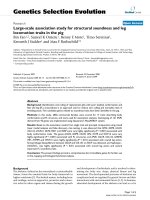

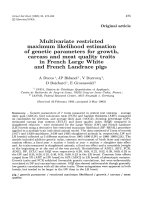

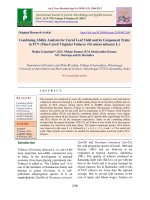
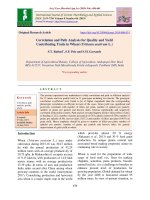
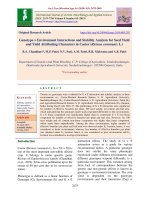
![Studies on correlation and path analysis for grain yield and quality components in foxtail millet [Setaria italica (L.) Beauv.]](https://media.store123doc.com/images/document/2020_01/09/medium_dyd1578574836.jpg)

